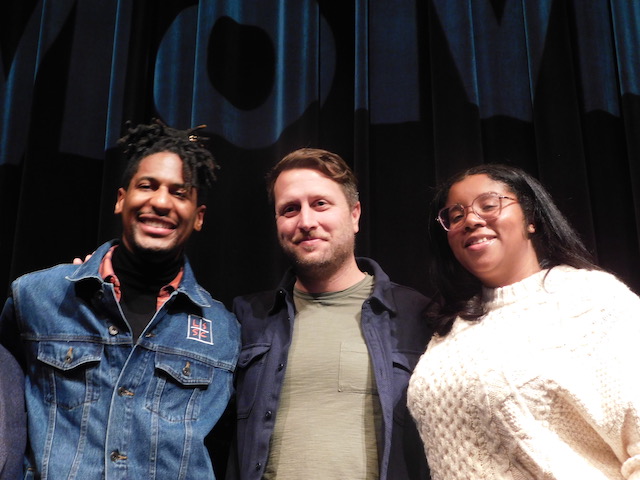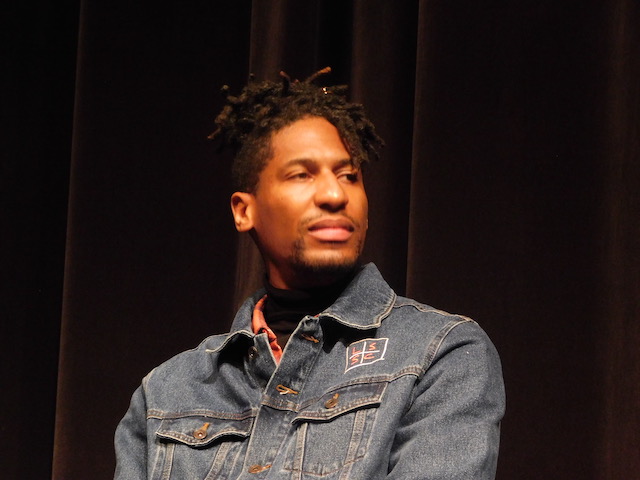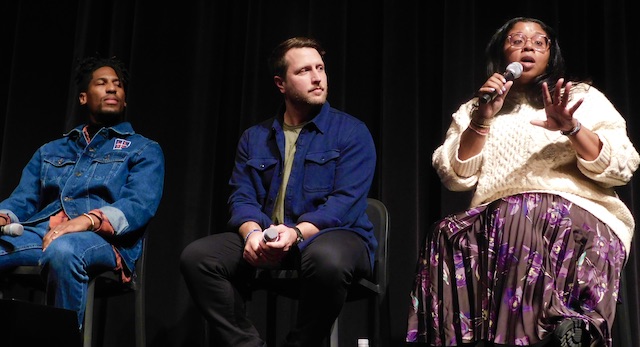
Photo by Nobuhiro Hosoki
American Symphony :Early in 2022, multi-instrumentalist Jon Batiste finds himself the most celebrated artist of the year with eleven Grammy nominations including Album of the Year. In the midst of that triumph, Jon is immersed in his most ambitious challenge yet: composing American Symphony, an original symphony that reimagines the traditions of the classical form, bringing together an expansive and inclusive diaspora of music for a performance at storied Carnegie Hall.
This extraordinary trajectory is upended when Batiste’s life partner — best-selling author Suleika Jaouad — learns that her long-dormant cancer has returned. In the intimate AMERICAN SYMPHONY, Academy Award-nominated and Emmy Award-winning director Matthew Heineman (Cartel Land, The First Wave, Retrograde) delivers a portrait of two inimitable artists at a crossroads and a profound meditation on art, love, and the creative process.
Rating: PG-13 (Some Strong Language)
Genre: Documentary, Music
Original Language: English
Director: Matthew Heineman
Producer: Matthew Heineman Lauren Domino, Joedan Okun
Release Date (Theaters): Limited
Release Date (Streaming):
Runtime:
Distributor: Netflix
Production Co: Higher Ground Productions, Our Time Projects, Mercury Studios
Sound Mix: Dolby Digital

Photo by Nobuhiro Hosoki
Q&A with Artist Jon Batiste, Director/Producer Matthew Heineman, Producer Lauren Domino
Q: Jon, the film is an incredible look at the intricacies of the creative process. What is life like living inside your mind? You hear all this noise, you’re singing, improvising, and then, it just needs a little more than that.
Jon Batiste: Hello. I’m always thinking about things that I don’t know that I’m thinking about. My subconscious mind is always going.
Q: The known and unknowns?
Jon Batiste: It’s happening and I feel something churning when it really gets going and then it diverges. It’s so hard to make some visuals more than not. Something I can’t explain, but the subconscious is working and there’s things that are happening in the present — and then both are working. They come together in moments and that’s typically where the music comes from.
Q: Matt, what’s it like to have an artist like Jon as the subject, the protagonist of the story?
Lauren Domino: I’ll start by saying it was a tall order for us to match Jon and Sulaika’s energy. They are so open and kind — throwing themselves into the process — that it challenges us as filmmakers, as a team, to be like, “How do we meet them at their level?” So, it really forced us to be like, “Okay, they’re opening their lives up and are so vulnerable. How do we open up and become more vulnerable so that we can meet the energy and the footage where it gets at?” It’s the most amazing thing that made me feel that when people open themselves up, it forces you to open and change happens. I know our team feels we’re better people. For them, sharing their lives and story, it made us do the same on a deeper level, so art heals people. It starts with people making the work. Jon and Sulaika gave so much of themselves that allow us to have it.
Matthew Heineman: I think we all owe so much to them for opening themselves up during such an unbelievably vulnerable and sensitive time of their lives. I’ve always tried to approach filmmaking in a very improvisational way. Every film I’ve ever made is something completely different than when I started. And this film is no exception. It was really fun to apply that ethos of filmmaking to one of the greatest improvisers in history. And to dance with him… in both the macro sense of trying to structure this story and in a micro sense, within each day shooting and within each shot.
Q: There’s so many moments of profound insight in the film from you, Jon and the people around you — through your relationships with them and your creative process. At one point you talk about genuine acceptance and gratitude which requires so much humility and self-awareness. How did this function in your work?
Jon Batiste: The thought of being great is a dangerous idea. When you’re creating music in the most pure sense, you become a vessel of something that you don’t fully understand and couldn’t ever fully grasp. The music is a way to point at it and share it. That’s always going to be greater than you. Now, if you get used to functioning in that stream of consciousness, that creative place that all the ideas come from, you can start to think that it’s you.
That’s where self-awareness comes from. Even though I have so many ideas all the time, and I’m always creating. I’ve always managed to make it happen. I can lose that one day, anybody can, because it’s not me. That’s an important part of the work. That’s how it functions in the work. It’s the most crass and direct sensibility of thinking about how it functions is, you ain’t great, bad. You’re just a vessel. If I can stay in that space then the world will be great.
 Photo by Nobuhiro Hosoki
Photo by Nobuhiro Hosoki
Q: Matthew, can you talk about how different it was in making this film from making some of your others. Being an artist yourself, right, and witnessing, filmmaking is really a profound act of witness. Jon’s process and Sulaika’s relationship, talk about what it was like to use your craft to show us their journey.
Matthew Heineman: Obviously, if you look at the films I made, this is definitely different yet in many ways it is the same. I approached it with the same fear, I think, that I approach every film. Am I going to fail? How am I going to do this? We have an amazing team, obviously, making this film. But it was an exorbitant film, and we had to really commit to this process. At first, Sulaika didn’t want to be part of the film, apprehensive of being seen as the sick wife in this story.
It took a lot of trust building with her and with Jon to make them comfortable with my very immersive style of filming. We were shooting 12, 16, 18 hours a day, seven days a week for seven or eight months. We shot 1500 hours of footage. It was a real commitment. After about a month or so, we’d all go over to each other and were like, “If we’re going to do this, let’s really truly do this and commit to this. The thing that probably scared me the most was depicting the artistic process, depicting what Jon just described, this sort of magic that he just channels as a vessel as he said.
I think that moment after he dedicates the song to Sulaika, we hold on that shot for 92 seconds or however long it was. In most films, it’s a strange choice to hold in silence for so long. It was like Jon literally writes the story for us. With all this weight on his shoulders, his love for Sulaika, how he’s changed life into art, and art into life. It’s all there on his face, his hands, his left and right hand. I just love telling stories without words, telling stories with emotion — and shooting based on emotion.
Q: When you talk about shooting and capturing emotion in the film, there’s just so many moments. There’s things that you can tell about couples that typify a relationship, where you can see the relationship without having to describe it. These two are just in it. Everybody knows how much you love your wife, which is really good.
Jon Batiste: That’s one of the things I noticed. I was like, “Man, that’s a good choice. Yes indeed!” I’m always joking around in that situation about the reality of not knowing if she was going to make it. All of the things that were going on outside the hospital and in the hospital room, that element of the relationship is like a force field. I didn’t realize what that would look like and how much that’s something that insulates us from the harsh realities of life. It’s really deep, the certain things in your relationship, value systems, humor, and creativity. They all become these means of survival.
That’s really one of the things that we picked up on and one of the things — from the beginning — that really brought us together and helped us weather a lot of things. I noticed that really did come across, as Matt and Lauren, as filmmakers and the production team, are finding a way to notice that in the footage and then carry that narrative thread throughout. That was powerful, because it also ties into the way that the themes of the score and the symphony tie in with the many themes within the film. It was very powerful to see that depicted through this truly masterful work by this team.
Q: Matt and Laurie, one of many things that was on your plate in the production of this film. It takes 14 minutes before the first few notes of what we will eventually discover is the beginning of “American Symphony.” It’s just so great, it’s really subtle. It really has wonderful touches about the actual concert at Carnegie Hall and what that must have been like. Jon is just getting started and then the power goes out. Only people on the stage realize exactly what is going on. Everyone else is like, “Well, the lights are on, everything’s fine, I’m not sure what’s happening.” Then Jon literally plays the power back into existence. Jon is literally at the piano and conjures electricity. How did you deal with that situation? What were you doing? You’ve got folks with cameras all over recording it all.
Lauren Domino: We had two different experiences at that moment. As a producer, this is what your anxiety dreams are about. I awake and dream. Another producer, Joedan Okun, and I looked at each other and we’re like, “Is it our fault?” We had 13 cameras, a very large crew, and we’re bringing in all this extra equipment. We’re like, not only did we break Carnegie Hall, but we had one night to shoot this. It involves a lot of electronics and it felt like a fever dream — the lights are on but key elements can’t happen, so my blood pressure went up almost like I had a heart attack.
Then you just hear Jon channel it and Matt has been in a war zone’s true life or death situation so he’s just fine. Just bring the steadicam closer. We’re like “Oh my god this is a nightmare and then Jon starts playing, but it’s a thing that I feel like the trauma of it just got erased until we were in the edit and we could watch it. Then you sit back and you’re like, “Wow, I need to meditate more and learn about patience and trust.”
Trust is the foundation for everything. Just to trust in these moments where things feel like they’re falling apart, but are actually coming together in beautiful ways, that’s bigger than you would expect. Things that John has really taught me, trust, just sitting back, waiting, and letting change happen. I thank them and so does my blood pressure. It was insane.
Matthew Heineman: I saw that Steadicam and I was just like, “That’s not even sending in the camera to get that shot. I definitely was like, “Wow, this is great.” To be honest, it was very confusing. There’s confusion with Jon and confusion about what is happening. The lights are on, but electronics are not on. Oh, all the recording devices are off. It had been a pretty long battle with the folks at Carnegie and various other entities to get a steadicam on stage.
For me, it was really important to see that experience through Jon’s eyes, to hear the creak of the bench, to see the sweat on the brow, to see the crowd from his perspective. That’s the man who literally — I can tell you — walked into Carnegie Hall, and was up there to date. Thankfully, I won that battle. And if it wasn’t for that Steadicam, that whole experience wouldn’t have been recorded. The shotgun mic on the Steadicam is the sound source for that moment and it’s a beautiful moment. It’s so indicative of Jon. He takes a second, breathes it in, and he’s like, all right. Well, I’m impressed. It ties the film together in a really beautiful way.
Jon Batiste: The great Joe Salem, the drummer who I played with since we were in high school, he’s from Pennsylvania, and wears a cowboy hat. Joe has noticed this theme, it’s almost like a tradition from every show that we’ve played for almost 20 years. Something always goes wrong [laughter]. Something always breaks or somebody’s pants split. The bass drum pedal will bust. Something will happen, the mic will shut. There’s a real beauty to that. Furthermore, I think there’s an actual purpose to that. There’s a divine logic, a cadence that’s meant to be a part of my work.
Often, I’ll create things in these moments within the composition. Nobody on the stage will know what will happen in specific moments. It’s designed for us to show up in a moment together. [So, there are blank bars on the page.] It will be even more abstract than blank. It will be creating a scenario. Sometimes that requires me, with this piece that I did, we had to create a notation that’s different to standard notation of music in order to get everybody to know it. Okay, this is the scenario.
Now that we’re in the scenario, let’s see. That was one that I didn’t initiate. But the beauty of it is now that piece that has improvised composition. The spontaneous composition of the moment will now be in “American Symphony” from henceforth. When we perform it again, this piece is now so. This is the beauty of these things, that happens. Discovery is always greater than adventure [applause].
Q: Your performance is seamless and comforting and yet so profound. It’s really obvious that you as the vessel, like you said, developed from clearly a strong faith.
Jon Batiste: The present is all we have. What we see in the present oftentimes doesn’t indicate the full range and majesty of the truth, of being, of who we are. Many times people see a person, but they don’t tell the good about his color. They see somebody and there’s so much in all of us. I have faith in people because there’s such a transformative power that people have within them. Beyond that, the creator of all things, the God of the universe, has created this planet and life force.
This moment in the celestial expanse of time, I have this measure that keeps changing and expanding. It’s un-understandable. It’s unfathomable. That in and of itself gives me faith that we can’t grasp what is, and we can’t know what will be. So, what’s left? The transformative power that we have within us, the trust and belief in the thing that created this whole existence as we know it… We can measure it to a limited capacity.
What we create and make so infectious, is so inevitable, so true and profound, real and moving. It’s drawing us in and speaking to something greater than ourselves. It’s showing us a way to something else that we can’t even articulate. What a beautiful thing to do, share and be in the world. I could go on and on about faith, but I’m just grateful that God put it in me to share a message that will uplift and help people.

Photo by Nobuhiro Hosoki
Check out more of Nobuhiro’s articles.
Here’s the trailer of the film.

